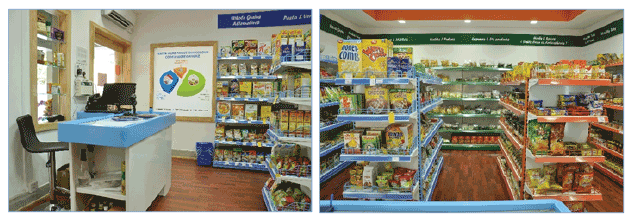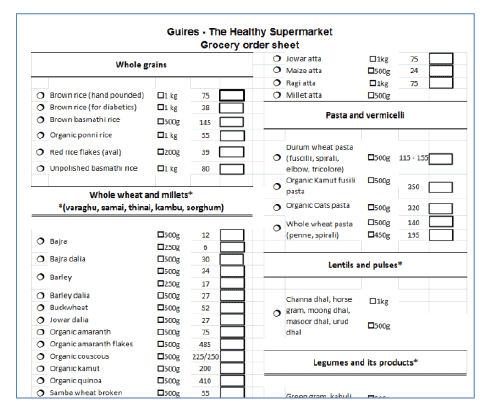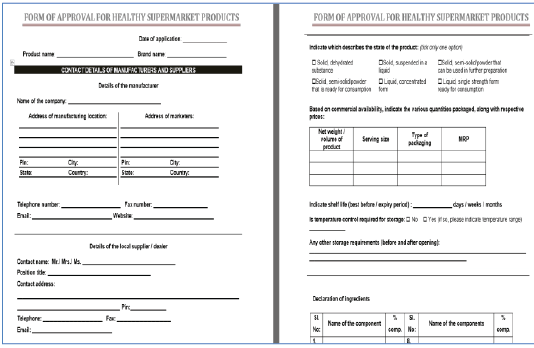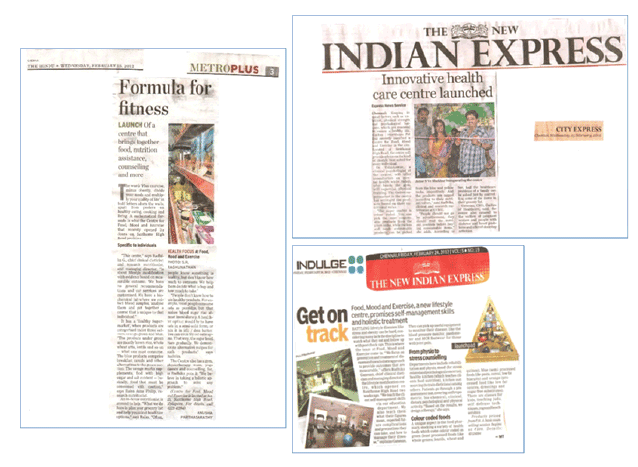
Figure 1: The Supermarket Model with ‘Color coded’ Concept (Source: The Guires Healthy Supermarket, Chennai).

Radhika Ganesan*
Association of Health, Food, Nutrition & Dietetics, Nungambakkam, Chennai, India*Corresponding author: Radhika Ganesan, Association of Health, Food, Nutrition & Dietetics, Nungambakkam, Chennai, India, Tel: 9144- 4212 4284; E-mail: info@afnd.in
The issue of obesity is on the rise especially in an urban metropolitan city of Southern India, Chennai. The effects of globalization and westernization coupled with unique Asian Indian phenotype worsened the scenario. Increasingly, public health strategies focusing on environmental determinants of overweight and obesity, an appropriate area of intervention. This has warranted an innovative approach that focuses both population and individual-based prevention strategy to mitigate obesity epidemic. This article presents such an innovation of nutritional education via the ‘healthy supermarket’ model. Though there are supermarkets that propagate healthy food, none has been effective in promoting the awareness on healthy eating, predominantly because along with healthy food, high processed food is also sold. This model, however, used a colour coded method, along with additional labeling of ingredients, in-house nutritionists and posters for education and information. The main barriers faced were related to those of the suppliers, manufacturers, nutritionists, consumers as well as the fiscal aspects of sustaining such a supermarket. However, the upkeep of such a concept requires a multifaceted approach such as support from the public health authorities, need for specialties within the occupation of nutrition and dietitians, who can recognize obesity as being a specialist area of dietetic practice, and promotion of social entrepreneurship. To conclude, the strength of this education model includesreal-life setting, the new design of supermarket and similar concepts can be setup or the existing ones can be remodeled with a sustainable business model for policy changes. In order to observe the success of this model on chronic diseases epidemiology, this model needs to be replicated in different areas of Southern India and other regions with the concept of ‘the food pharmacy’.
Nutrition; Overweight and Obesity; Healthy supermarket model; Prevention and management; Urban Southern India
An enormous increase in the onset of metabolic diseases has overburdened public health of both advanced and developing nations alike. India shoulders this burden of both under nutrition and over nutrition in the same population across the life course. Indeed, Indians have a unique phenotype, that makes them susceptible to chronic diseases at a younger age and lower body mass index due to thrifty phenotype and rapid westernization [1-3]. Currently, 20% [4] of all adults and 11% of all children are obese [5] with an upsurge of plus-size stores at stupendous rates in the retail market [6] depicting the rise of obesity, demanding increased focus on its prevention and management [7,8]. Most of the traditional education-based nutrition interventions that have targeted at individual determinants of dietary intake are unlikely to be effective today in the absence of broader structure support [9]. Public health policies focus [10] has identified the strong and environmental determinates of overweight and obesity an appropriate area for intervention in which an evidence-based exists to guide action [11].
In India, public health strategies designed to tackle behavioral risk factors for chronic diseases was largely focused in the form of awareness programs, and fiscal and regulatory measures [12,13]. To our knowledge, there is a lack of a single population based strategy that focuses on a balanced approach to improving nutrition security by ensuring the availability and consumption of nutritionally appropriate diet at all stages of life. The supermarket model was one such strategy that may help individuals to make healthier choices about what to eat and may be associated with better health outcomes [14]. The supermarket and grocery stores, the primary location for food purchases, are receiving increased attention. Yet, instore marketing to promote healthful eating was conducted in controlled laboratory and field experiments, and observations [15] but to our knowledge, not many have tested in real-world in-store settings where the real challenge exists. The present article, therefore, discusses the challenges involved in setting up the ‘The healthy supermarket’ in the real-world for the prevention and management of obesity in urban Chennai, Southern India.
Supermarket market was designed based on available scientific researchbased evidence from Indian context [10,12,16] and in absence, best practices from developed nations including systematic studies and public health policies [17,18] published by World Health organization (WHO), Food and Agricultural Organization (FAO), Centers for Disease Control and Prevention (CDC) [19] across the world [20] have been adopted and customized to fit Indian based culture. The previous systematic review [19] concluded that front-of-pack labels especially ‘traffic light’ labels were the most liked and readily understood by consumers and effect on sales and consumptions [21,22]. Further, especially on the impact of nutrients lists and interpretive label, health-related printed materials distributed [23], food demonstration, menu signage [24], Glycemic Index (GI) choices, recipe cards, placard on shelf near target food, fact sheet [25,26], nutrition education tours given by nutritionists [27,28], shelf labels, cooking demonstration [29-33], and culturally relevant guidelines shown to effective in previous intervention models have been considered while designing the supermarket.
‘The healthy supermarket’ was commenced with a broader objective of modifying behavior of consumers towards healthy food choices thereby aiding in the prevention and management of obesity for the population in Chennai (Southern India). This model integrated behavioral changes in reference to food choices of consumers based on nutrition education. ‘The Healthy Supermarket’ was intended for its consumersto a) increase the access, availability and consumption of healthy foods, b) increase consumer awareness and knowledge of nutritional claims and labeling facts, and c) self-efficacy and modification of behavior regarding healthy food choices and preparation. The specific goals of nutrition education were to a) create awareness on different food groups and importance of functional foods, b) notify on major nutrient composition, importance and requirement of micro and macro nutrients, c) emphasize the importance of the quality of food; d) educate on the diseases associated with excess or deficient nutrient intake, e) inform on food marketing strategies, labeling and influences of regulation on consumers’ choice of food, f) educate on spending on food versus medicine.
The nutrition education program through ‘The Healthy Supermarket’ model consists of variations that make this supermarket and dissemination of nutrition education unique. The concept involved: A) A ‘food philosophy’ was introduced where supermarket did not accommodate foods in which the very first ingredient contained were either trans-fat, high levels artificial colour and preservatives, higher levels of glucose or fructose, corn syrup, sugar and or refined flour (Maida or white flour). The philosophy was further stringent in adhering to the United States (US) Food and Drug Administration (FDA) regulations updating periodically as per future research [34]. B) Full-time an in-house supermarket nutritionist. C) Colour coded racks to segregate foods based on their level of processing involved (Figures 1-6). Green depicting the least processed products including foods from basic five groups (e.g. cereals, pseudo-cereals, millets) and functional foods (psyllium husk, garlic and fenugreek seeds). Blue for semi-processed products while the orange for highly processed food. D) additional labeling strategy on the products and shelves, shelf tags, and small posters i) star indicators: blue stars for high fiber, red for high sugar, yellow for high sodium and green for whole grains, where the number of stars dependent on the serving size ii) Recommended dietary allowances (RDA) [35] for all the possible food groups and nutrients. iii) Posters on oats- reduces LDL cholesterol levels- amount specified by US FDA [34,36] with the portion tools ((teaspoon) on display), recommended versus the actual intake (per recent studies in Chennai) [37], posters, and recipe booklets.
E) Models on GI, healthy eating food pyramid (Harvard Nutrition Pyramid Culturally Modified based on available evidence) [38] and portion size tools, F) Booklet on obesity enumerating the facts, contributing factors, preventive methods, myths and alternative healthier recipes for popular restaurant foods. G) Recipe sheets on healthy food preparations, practical tips on how to eat in moderation (by consuming less fat and more fruits and vegetables), highlighting the importance of low-fat dairy and cookery demonstration on the effects of food processing on digestion are part of the healthy supermarket and kitchen with live demonstration setup for prevention and management of chronic diseases such as diabetes Further, organic foods were not highlighted due to lack of evidence against its inorganic, expensive and less appealing to consumers in terms of shelf life and low awareness. In addition, the foods that had a special claim, manufacturers and suppliers were requested to produce evidence.
The healthy supermarket similar to any novel venture encountered several barriers for implementation from a number of stakeholders involving consumers, manufacturers and suppliers, nutritionists and government.
The food based environment was designed after careful review of local (India, Southern India, Chennai) health behavior, nutrition status, and chronic diseases prevalence along with demographic and socio-economic data, customer perceptions and policy data [39]. Yet, there are several challenges involved in translating the evidence. Firstly, one of the most significant hurdle was a lack of nutrient information for cooked foods, which challenged to translate the dietary guidelines in terms of more realistic portions [16,40]. Secondly, lack of cultural based standardized serving, portion tools and food atlas. Thirdly, lack of standardized food and nutrition labels across the food products. Fourthly, not many foods based environment intervention studies conducted previously in India, unlike western which further limited our model. Fifthly, availability and accessibility of many healthier foods in local area was challenging and further importing added to the costs, therefore affordability was questioned. Although there was a fair amount of support from consumers, but a lot of criticism and resistance from suppliers, nutritionists and retailers.

Figure 1: The Supermarket Model with ‘Color coded’ Concept (Source: The Guires Healthy Supermarket, Chennai).

Figure 2: Health Kitchen for Live demonstration

Figure 3: Sample of grocery form
Although Food Safety Standard Authority of India (FSSAI) guidelines [41,42] suggest the nutritional facts on the label along with energy and other nutrients, but it was observed the majority of the products lack such information. The misleading information such as cholesterol ‘free’ or ‘No Sugar’ without sufficient evidence posed a challenge to nutritionists educate the consumer. Though the products were shelved per the color code and nutrition information, there was a recurring pressure from food suppliers to display their products according to visual merchandising approach [43] (e.g. fast moving goods in front, such as low-fat chips). Suppliers refused to supply in small quantities and moreover demanded procurement of all their items of supply including foods against the ‘food philosophy’ which therefore lead to termination of healthy foods procured from them. Minimum shelf-life of less processed foods posed a threat until they were procured by consumers resulting in a frequent return to its reluctant suppliers.

Figure 4: Nutrition Approval form

Figure 5: Shopping Checklists
It was observed that a major source of nutrition information was advertisements in print and television media, and physicians’ suggestions surpassing a nutritionist’s role. On the other end, consumers are prejudiced and often caught up in the quick fix solutions to lose weight, lower cholesterol, and blood pressure owing to the misinformation about nutrition and propaganda of solutions through media. Obesity is yet to be viewed as a threat to public that leads to the onset of recognized diseases like diabetes, heart disease and hypertension. Even when nutritionist explained about its results and effects in the long term, consumers are reluctant to consider these facts. Further, from the consumer perception, the model was more viewed as exclusive store due to the non-availability of fast moving consumer goods (FMCG).

Figure 6: Promotion of Supermarket Model, Published in local News Paper
A large amount of money is spent on high-quality and sophisticated research to invent new and effective procedures and model, with an objective behind to help healthcare professionals provide the best possible care. Yet, it was found that nutritionists had the inability to translate the evidencebased practice (EBP) model to the community including management of manufacturers and suppliers, detecting nutrient information of foods in terms of labeling and misinformation and relating it to its effect on health. Majority relied on experiences and opinion while educating consumers, but making a shift from a traditional emphasis on authoritative opinion to an emphasis on data extracted from prior research studies was a huge challenge. There are several reasons such lack of time, limited theoretical (nutrition) and IT skills, lack of searching skills, insufficient evidence, lack of autonomy to change practice, resistance (or negative attitude) towards EBP, which further limited their decision-making skills of the recruited nutritionist.
Nutritional education through this model was far reaching and applauded by the consumers; the financial viability was still not promising as it very sustenance was challenging due to above-mentioned factors. Population based public health initiatives are still at the ground work in a reference to obesity especially when the models are translated to real-life setting or in terms of the viable business model. An important challenge was to obtain loan and loan repayment facility, especially consideration to support and promote women entrepreneurs. It is increasingly recognized that environmental programs play an important role particularly fiscal policies that reduce barriers or increase opportunities for healthy choices, such as subsidies or taxation for certain fatty /sugary foods, has received considerable attention to achieve population-wide behavioral changes [44]. However, not many subsidies are provided by the government for pricing of healthier food products. Moreover, the convenience of availing unhealthy food products at slashed rates or their smaller versions at affordable prices even by the low-income population has promoted the choice of such unhealthy foods.
The ‘healthy supermarket’, while a novel idea, does require much support from governing bodies in addition to the cooperation from manufacturers and food suppliers. Yet, to mitigate the obesity epidemic, there is a need to address challenges from multi-sectoral response involving the media and celebrity promotions, consumers, public and private healthcare professionals and non-government sector. Further, there is a need for specialties within the occupation of dietitian and nutritionists such as recognizing obesity as being a specialist area of dietetic practice, which perhaps create more impact on mitigating the epidemic. The government needs to recognize social entrepreneurs, who have a unique blend of profit best practices with the non-profit mission as a unique way of tackling the obesity epidemic in India. To conclude, the strength of this education model includesreal-life setting, the new design of supermarket and similar concepts can be setup or the existing ones can be remodeled with a sustainable business model for policy changes. In order to observe the success of this model on chronic diseases epidemiology, this model needs to be replicated in different areas of Southern India and other regions with the concept of ‘the food pharmacy’.
We thank, Guires Healthcare (P) Limited, Chennai for funding to develop and implement ‘The Guires Healthy Supermarket’ Model. The concept was conceived by the Author (Dr. Radhika Ganesan, Founder and President of Association of Health, Food, Nutrition and Dietetics, Chennai, India).
Download Provisional PDF Here
Article Type: Opinion Article
Citation: Ganesan R (2016) The Healthy Supermarket, an Integrated Model for Prevention and Management of Obesity: Translational Challenges in Real-world in-store setting in Urban Southern India. Nutr Food Technol 2(1): doi http://dx.doi. org/10.16966/2470-6086.113
Copyright: © 2016 Ganesan R. This is an open-access article distributed under the terms of the Creative Commons Attribution License, which permits unrestricted use, distribution, and reproduction in any medium, provided the original author and source are credited.
Publication history:
All Sci Forschen Journals are Open Access